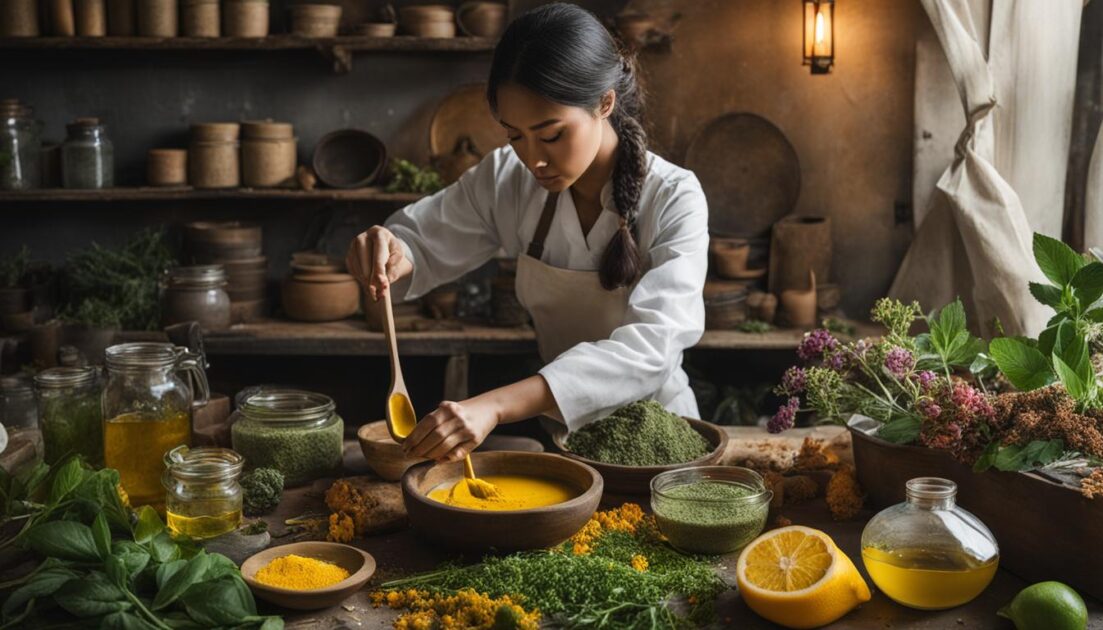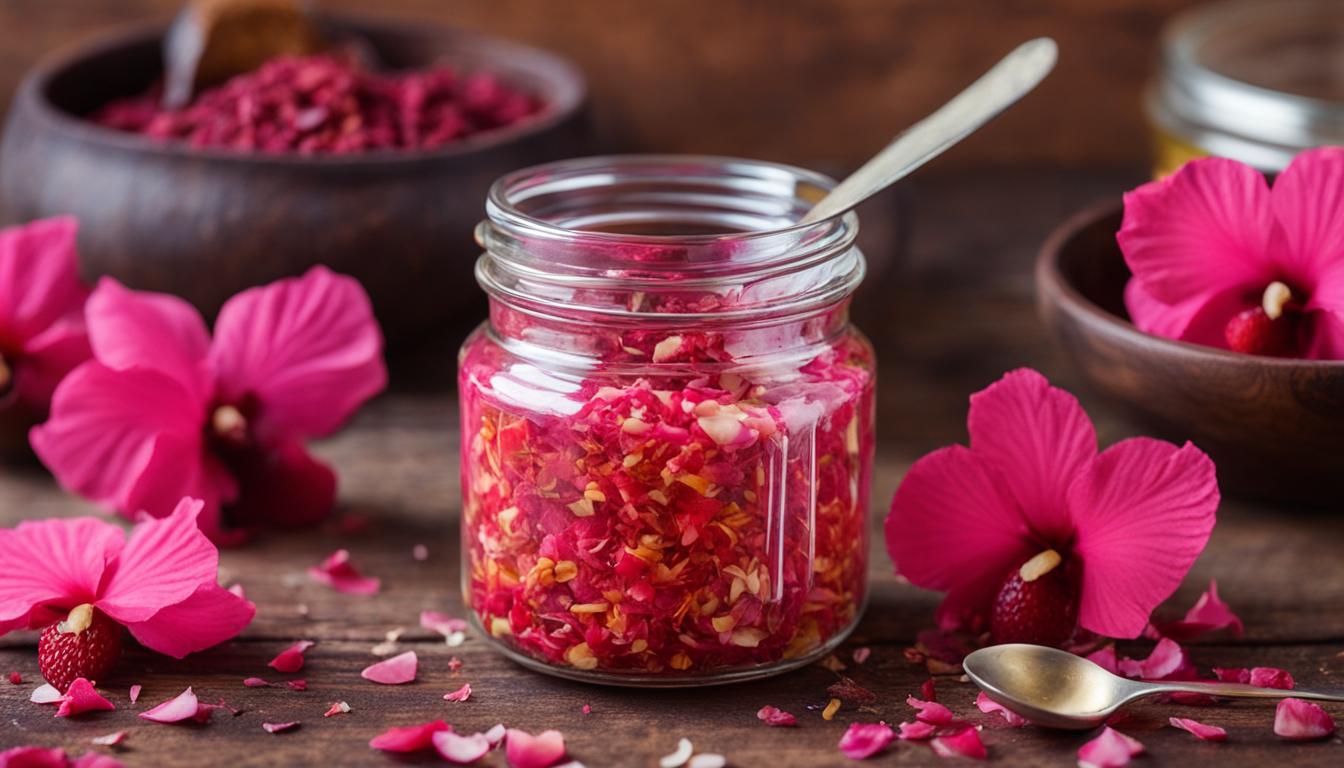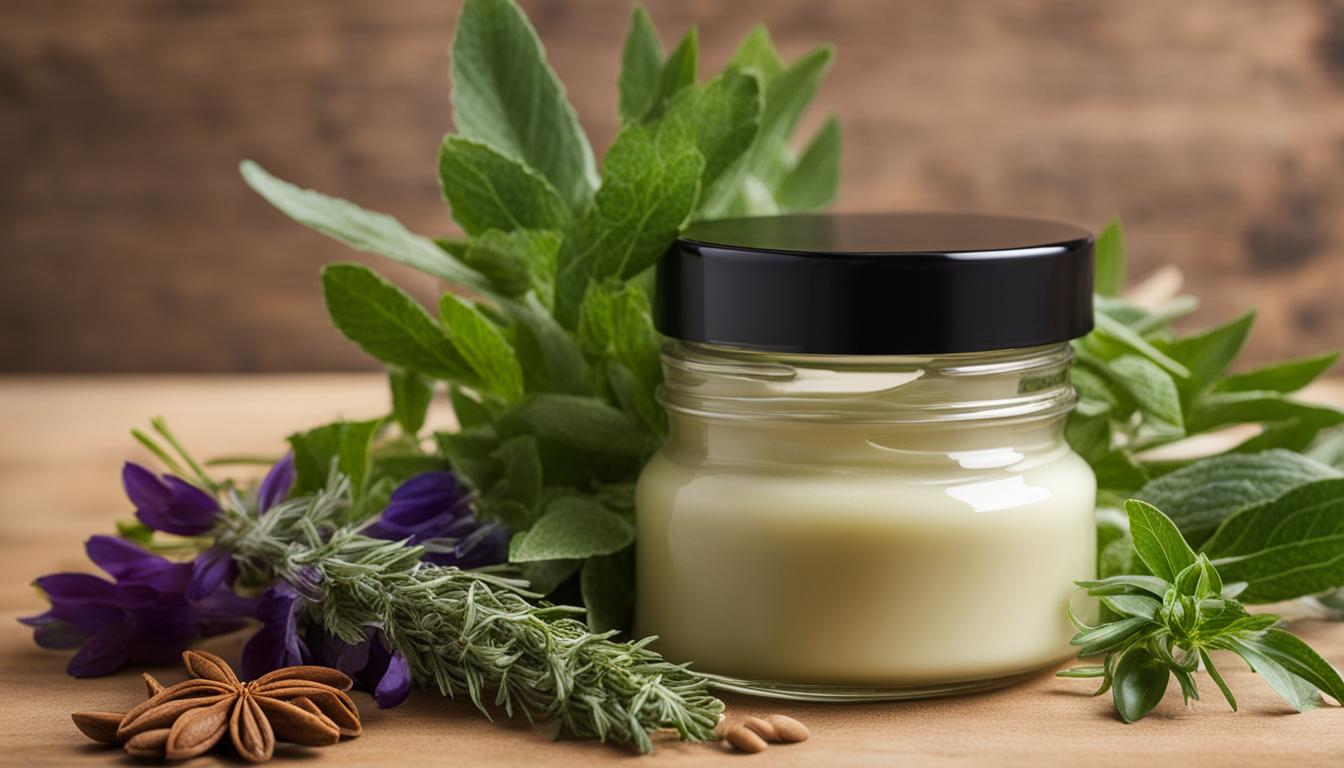Making soap with natural ingredients is a rewarding craft that allows you to create personalized, organic soaps at home. By using pure ingredients like vegetable oils, lye, and water, you can make gentle and nourishing soap that is free from harsh chemicals. In this guide, I will explore the process of natural soap making, including the different types of fats and oils that can be used, essential oils for scent, natural colorants, and other additives. With this knowledge, you can create your own handmade, organic soap with ease.
Key Takeaways:
- Natural soap making allows you to create personalized, organic soaps at home.
- Using pure ingredients like vegetable oils, lye, and water ensures that your soap is free from harsh chemicals.
- Explore different types of fats and oils, essential oils for scent, natural colorants, and additives to create unique soap recipes.
- Making handmade soap allows you to customize the ingredients and create a product that suits your skin’s needs.
- With the right knowledge and techniques, you can enjoy the process of creating your own natural soap.
The Essential Ingredients for Natural Soap Making
Making natural soap requires a few key ingredients that form the foundation of the soap-making process. These essential components are fats, lye, and water.
Fats: The fats used in natural soap making can come from various sources. Vegetable oils like olive oil, coconut oil, and palm oil are popular choices. Animal fats such as lard or tallow can also be used. These fats provide the necessary moisture and nourishment for the skin when transformed into soap.
Lye: Lye, also known as sodium hydroxide, is a critical ingredient in soap making. It is caustic and needs to be handled with caution. When combined with fats, lye triggers a chemical reaction called saponification. It is during this process that the fats are transformed into soap. Proper measurements and safety precautions are crucial when working with lye.
Water: Water is used to dissolve the lye and create the lye solution. It helps initiate the saponification process by combining with lye and fats. The amount of water used in soap making impacts the hardness and curing time of the soap.
These three ingredients work together in a delicate balance to create natural soap that is gentle and nourishing for the skin. The following table summarizes the essential ingredients for natural soap making:
| Ingredient | Function |
|---|---|
| Fats | Moisturizing and nourishing the skin |
| Lye | Triggering the saponification process |
| Water | Dissolving the lye and combining with fats |
It is important to use high-quality fats, pure lye, and filtered water to ensure the best results in your natural soap making endeavors. Now that we have covered the essential ingredients, let’s explore how different fats, lye, and water ratios can produce unique soap bars with varying properties and characteristics.
Adding Scent and Fragrance to Your Soap
Enhance your bathing experience by adding enticing scents and fragrances to your handmade soap. The use of essential oils and fragrance oils can infuse your soap with captivating aromas that uplift your senses.
Essential oils are concentrated plant extracts known for their aromatic properties. They offer both delightful scents and potential therapeutic benefits. When using essential oils in soap making, it’s essential to select oils that are safe for skin application and ensure proper dilution.
Choosing Essential Oils
Commonly used essential oils in soap making include:
- Lavender: Known for its calming and soothing properties.
- Peppermint: Provides a refreshing and invigorating scent.
- Citrus Oils (such as orange, lemon, or grapefruit): Offer vibrant and uplifting fragrances.
- Floral Scents (like rose, jasmine, or ylang-ylang): Impart a delicate and romantic aroma.
The usage rate of essential oils in soap recipes is typically around 3% by weight of the soap, excluding water. This ensures a pleasant and well-balanced fragrance without overpowering the soap’s other qualities.
While essential oils are derived from natural sources, fragrance oils are synthetic and do not possess the same natural properties. However, fragrance oils provide a broader variety of scents and can be an alternative for those seeking unique fragrances that may not be available in essential oil form. When using fragrance oils, it’s important to check for skin-safe options and follow recommended usage rates.
Remember, whether you choose essential oils or fragrance oils to scent your soap, consider personal preferences, skin sensitivity, and ensure proper dilution to achieve optimal results.
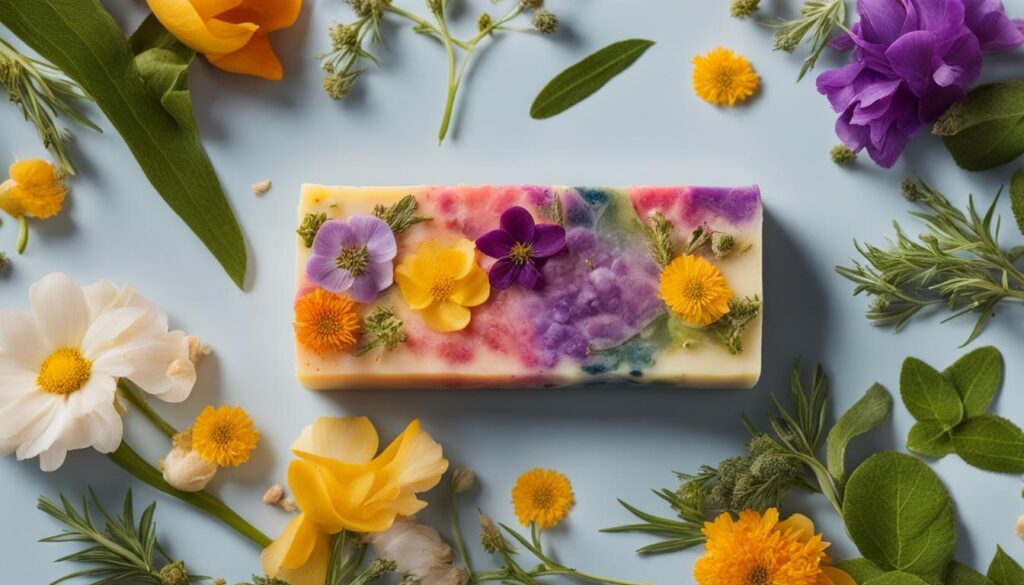
With the addition of your preferred scents, your soap will not only cleanse and nourish your skin but also envelop you in a delightful fragrance that makes each bathing experience a sensory delight.
Adding Color to Your Soap
Adding color to your soap can take your handmade creations to the next level. Natural soap colorants offer a range of beautiful shades and tones, allowing you to create visually appealing bars that are free from synthetic dyes and chemicals. Let’s explore some of the popular options for naturally coloring your soap.
Clays
Clays are widely used as natural colorants in soap making. French pink clay, for example, adds a soft pink hue to your soap. Other clays, such as green clay, yellow clay, and red clay, offer their own unique colors. These clays can be added to the soap batter at trace or mixed with distilled water before being added. Their gentle exfoliating properties also make them a popular choice.
Botanical Extracts
Botanical extracts, derived from plants, can infuse your soap with natural color. Alkanet root, madder root, and annatto seeds are common botanical extracts used in soap making. They can be infused into the lye solution or mixed with the main oils to achieve beautiful hues. The natural scents of these botanical extracts can also add a lovely fragrance to your soap.
Other Natural Colorants
In addition to clays and botanical extracts, there are other natural ingredients that can be used as soap colorants. Charcoal, derived from burnt wood or coconut shells, creates deep gray and black colors. Cocoa powder, spices like turmeric or paprika, and fruit purees can also be used to add vibrant color to your soap. These natural colorants not only provide visual appeal but also offer additional benefits for your skin.
It’s important to note that the choice of colorant depends on the desired effect and personal preference. Experimenting with different natural soap colorants can help you create unique and visually stunning soap bars that are both beautiful and gentle on the skin.
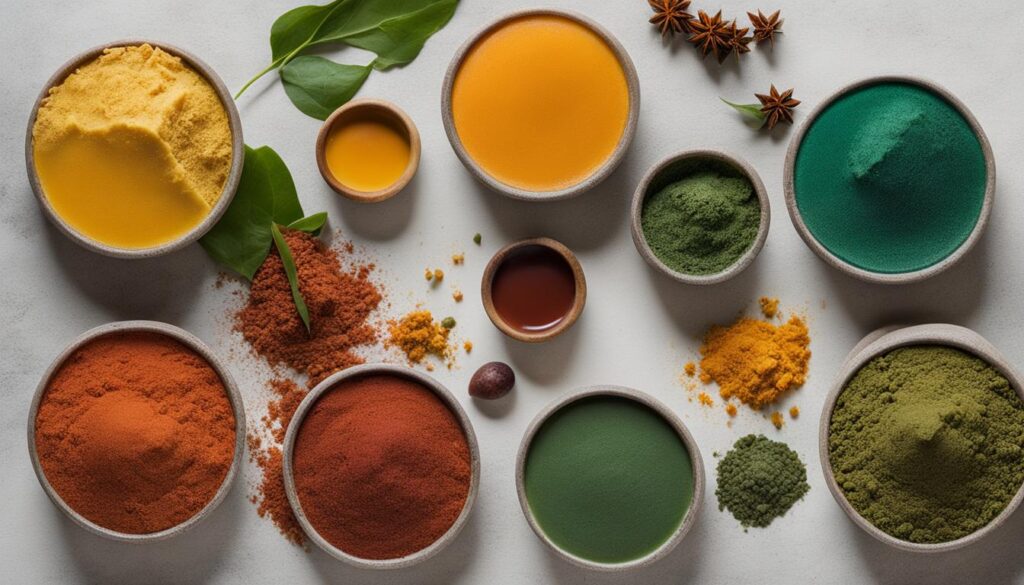
| Colorant | Color | Usage |
|---|---|---|
| French pink clay | Soft pink | Add at trace or mix with distilled water |
| Green clay | Green | Add at trace or mix with distilled water |
| Yellow clay | Yellow | Add at trace or mix with distilled water |
| Red clay | Red | Add at trace or mix with distilled water |
| Alkanet root | Purple | Infused into lye solution or main oils |
| Madder root | Red | Infused into lye solution or main oils |
| Annatto seeds | Yellow-orange | Infused into lye solution or main oils |
| Charcoal | Gray or black | Mixed with soap batter |
| Cocoa powder | Brown | Mixed with soap batter |
| Spices | Varying colors | Mixed with soap batter |
| Fruit purees | Varying colors | Mixed with soap batter |
Adding Texture and Exfoliation to Your Soap
Adding texture and exfoliation to your soap can create a unique sensory experience. By incorporating ingredients like oatmeal, sea salt, coffee grounds, and ground pumice, you can create an exfoliating soap that gently removes dead skin cells, leaving your skin feeling smooth and refreshed. It’s important to choose exfoliants that are suitable for your skin type, as some can be too abrasive for sensitive skin.
To enhance the aesthetics of your soap, you can also consider adding botanical additives. Dried leaves, fruit peels, seeds, and flower petals can be sprinkled on top of the soap or incorporated throughout the bar for a decorative touch. These botanical additives not only add visual appeal but also provide an element of texture to your soap.
| Exfoliating Ingredients | Botanical Additives |
|---|---|
| Oatmeal | Dried leaves |
| Sea salt | Fruit peels |
| Coffee grounds | Seeds |
| Ground pumice | Flower petals |
When using exfoliating ingredients and botanical additives, it’s essential to consider the quantity and placement for optimal results. The right combination of exfoliants and botanicals can create a soap that not only cleanses but also provides a spa-like experience for your skin.
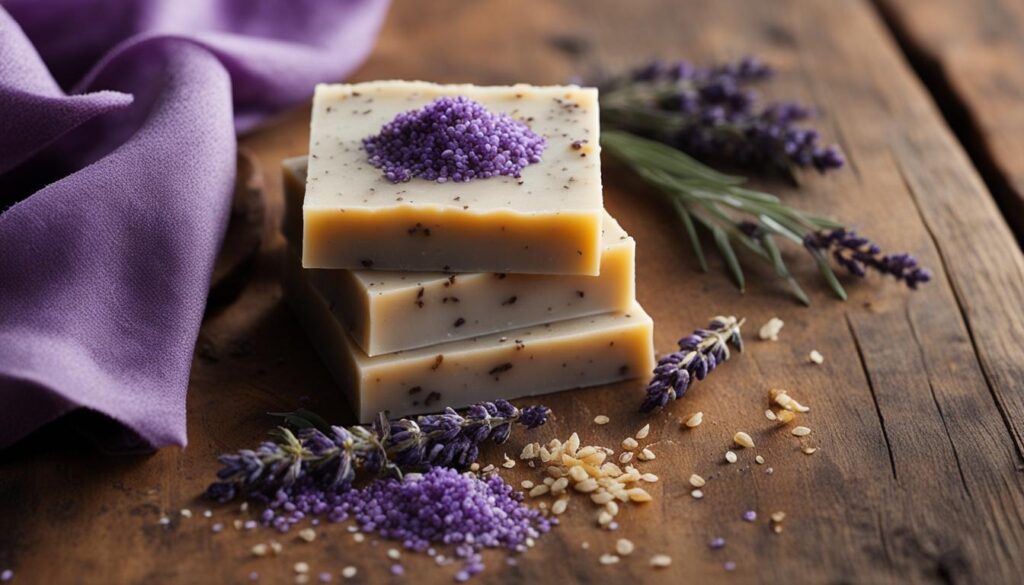
Choosing Additives for Specific Purposes
When it comes to soap making, additives can play a crucial role in achieving specific purposes. Whether you want to create salt bars for exfoliation and detoxification or add silk fibers for a luxurious texture, understanding the different options available can help you tailor your soap recipes to perfection.
Creating Salt Bars
Salt bars have gained popularity in recent years due to their potential benefits for acne-prone skin, exfoliation, and detoxification. By adding salt to your soap, you can create a bar that offers unique properties and a refreshing bathing experience.
It’s important to note that salt can affect the lathering ability of soap, so salt bars usually contain a higher percentage of coconut oil, which compensates for this effect. Coconut oil provides the necessary cleansing properties and helps create a creamy lather, ensuring that your salt bars deliver the desired results.
Enhancing Texture with Silk Fibers
If you’re looking to add a touch of luxury and silkiness to your soap, incorporating silk fibers is a fantastic option. Derived from cocoons, silk fibers can be blended into your soap recipes to create a silky texture that feels exquisite on the skin.
It’s important to note that silk fibers and liquid silk are derived from animals and are not considered vegan or vegetarian. However, for those who are comfortable using animal-derived additives, silk fibers can provide a unique sensory experience and enhance the overall quality of your soap.
Additional Additives for Soap Making
Aside from salt bars and silk fibers, there are various other additives that you can explore to customize your soap recipes. Beeswax, for example, can be used to add hardness and durability to your soap bars, making them long-lasting and resistant to melting.
When choosing additives, it’s essential to consider their specific effects and suitability for your desired soap recipe. Researching the properties of different additives and experimenting with small batches can help you find the perfect combination to achieve the desired results.
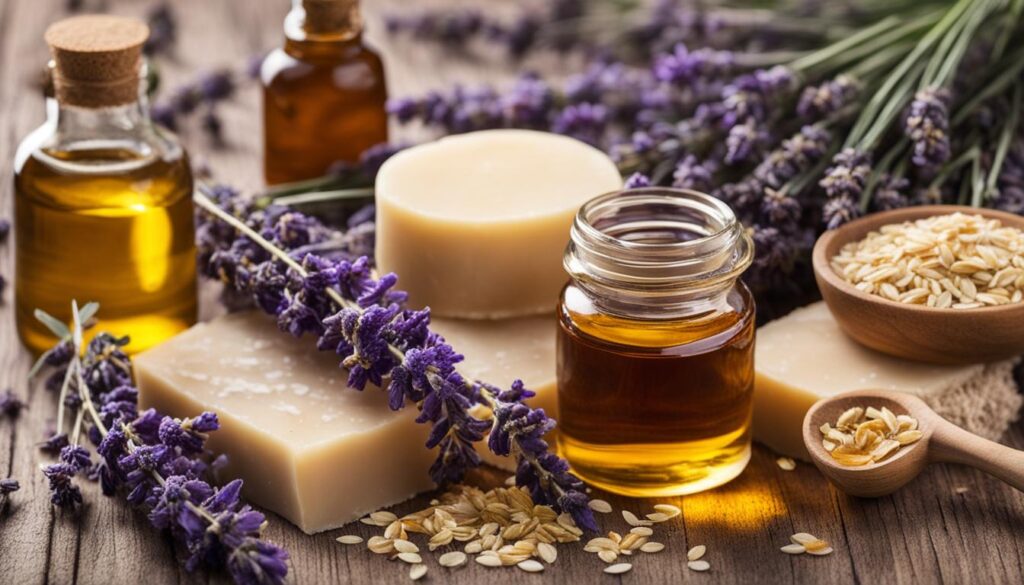
Decorating and Designing Your Soap
Decorating and designing your soap can add a personal touch and enhance its aesthetic appeal. Botanical decorations, like lavender buds, rose petals, and dried orange slices, can be used to adorn the tops of soap bars. These botanicals can be sprinkled on the soap before it sets or pressed into the soap during the cutting process. It’s important to use these decorations sparingly to prevent clogging drains and to consider their potential impact on the shower or bath experience. Soap design techniques, such as swirls, layers, and texture patterns, can also be used to create visually stunning soap bars.
When it comes to botanical decorations, the options are limitless. You can choose from a wide range of dried flowers, herbs, and fruit slices to create a beautiful and natural look for your soap. The key is to select botanicals that complement the scent and theme of your soap. For example, lavender buds can enhance a lavender-scented soap, while rose petals can add a touch of elegance to a rose-scented soap.
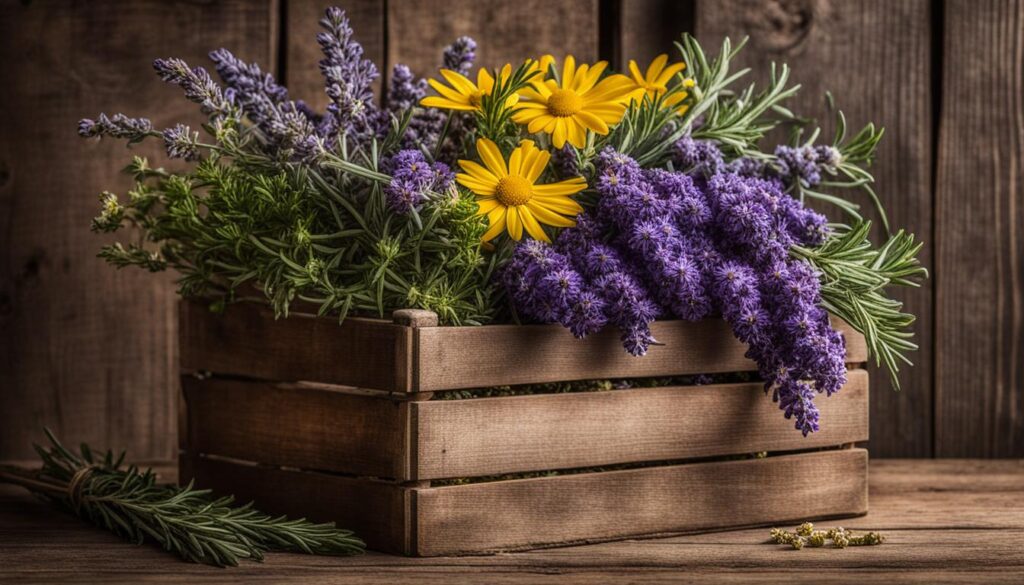
In addition to botanical decorations, soap design techniques can also play a major role in creating visually appealing soap bars. Swirls, for instance, can be achieved by carefully layering different colored soap batter and gently swirling them together with a skewer or a chopstick. This technique creates a mesmerizing pattern that adds depth and dimension to the soap. Layers, on the other hand, involve pouring multiple layers of soap batter into the mold, allowing each layer to set before adding the next. This creates beautiful color transitions and distinct layers within the soap. Texture patterns, such as using a textured soap mold or embedding exfoliants like oatmeal or coffee grounds, can also provide a unique and tactile experience for the user.
When designing your soap, it’s important to consider the overall theme or message you want to convey. Are you going for a rustic, farmhouse look? Or perhaps a modern and minimalist design? The choice of botanical decorations and design techniques should align with your desired aesthetic. Experimenting with different combinations and patterns can help you discover your own signature soap design.
Tips and Tricks for Natural Soap Making
When it comes to natural soap making, there are various techniques that can be used to create your own unique and personalized soaps. Whether you prefer the traditional cold process method or the convenience of melt-and-pour soap bases, each technique has its advantages and requires specific considerations.
1. Cold Process Soap Making: With the cold process method, you have complete control over the ingredients and customization of your soap. It involves combining fats or oils with lye to initiate the saponification process. This technique allows for more creativity in formulation and is ideal for those who enjoy experimenting with different oils, scents, and additives.
2. Melt-and-Pour Soap Making: If you’re looking for a simpler and quicker option, the melt-and-pour method is perfect for you. With pre-made soap bases, all you need to do is melt the soap, customize it with your preferred additives and scents, and pour it into molds. This technique is beginner-friendly, as it eliminates the need to handle lye, and allows for easy customization with various colors, shapes, and scents.
Safety Precautions
Regardless of the soap making technique you choose, it’s essential to prioritize safety. Remember to:
- Wear protective gear such as gloves, goggles, and an apron to shield yourself from any potentially harmful substances.
- Work in a well-ventilated area to avoid inhaling fumes.
- Follow precise measurements and instructions for ingredient ratios to ensure a safe and successful soap making process.
Experimentation is Key
Soap making is a creative process, so don’t be afraid to experiment with different recipes, techniques, and ingredients. Test out different oils, fragrances, essential oils, colorants, and additives to create your own signature soap. Keep a record of your experiments and observations to refine your techniques over time.
Tip: Don’t forget to take note of the specific ratios and methods used for each batch of soap, so you can replicate successful recipes in the future.
Continued Learning
Soap making is a continuous learning journey. Stay informed and immerse yourself in the craft by:
- Exploring books, online tutorials, and classes that provide detailed instructions, tips, and tricks for successful soap making.
- Joining online communities and forums where soap makers share ideas, experiences, and resources.
- Engaging in hands-on workshops or attending conferences and events dedicated to soap making.
Remember, practice makes perfect, and with time and experience, you’ll develop your own soap making style and create beautiful, natural soaps that are a reflection of your creativity and passion.
Comparison of Cold Process and Melt-and-Pour Soap Making
| Cold Process Soap Making | Melt-and-Pour Soap Making |
|---|---|
| Requires handling of lye | No lye handling necessary |
| Offers complete customization control | Convenient and ready-to-use soap bases |
| Allows for experimentation with various oils and additives | Easy customization with colorants, fragrances, and additives |
| Requires curing time for the soap to harden and mellow | Ready to use as soon as it cools and solidifies |
| Provides endless possibilities for creativity | Quick and beginner-friendly |
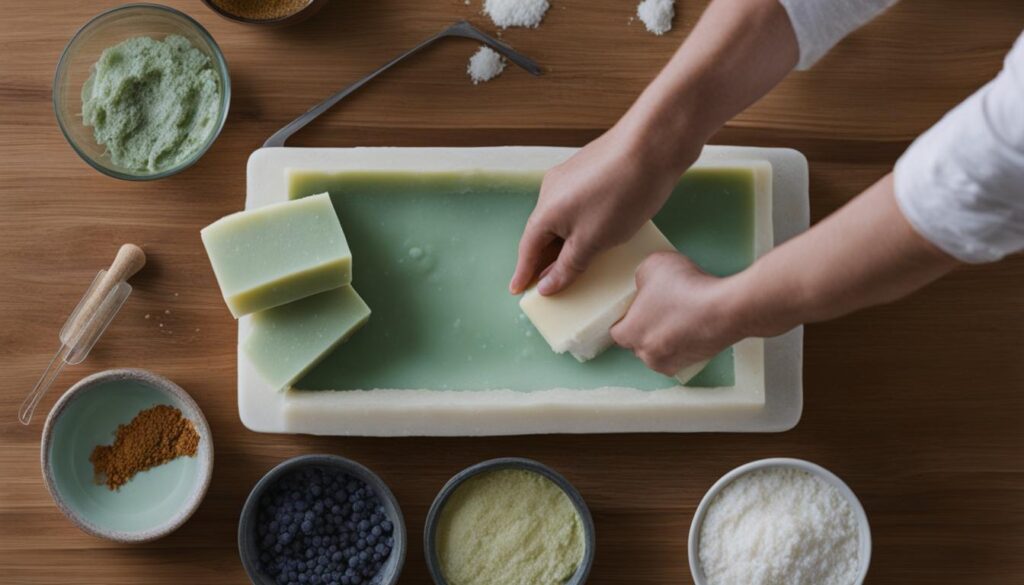
Further Resources for Natural Soap Making
If you’re interested in further exploring natural soap making, there are many resources available to guide you. Books, online tutorials, and classes can provide step-by-step instructions, recipes, and tips for successful soap making.
The Lovely Greens Guide to Natural Soapmaking is a comprehensive resource that covers the process of making handmade soap in detail. It provides information on ingredients, techniques, and troubleshooting. This guide is a valuable tool for both beginners and experienced soap makers looking to expand their knowledge.
Additionally, websites and online communities dedicated to soap making can offer a wealth of information, inspiration, and support. These platforms are a great way to connect with fellow soap makers, exchange ideas, and learn from their experiences. You can find discussions, tutorials, and even organic soap recipes to try.
By utilizing these soap making resources, such as the Lovely Greens Guide to Natural Soapmaking and online communities, you can continue to enhance your soap making skills, discover new techniques, and create beautiful and organic soaps that are both nourishing and eco-friendly.
FAQ
What are the essential ingredients for natural soap making?
The essential ingredients for natural soap making include fats, lye, and water.
What kind of fats can be used in soap making?
You can use vegetable oils like olive oil or coconut oil, or animal fats like lard or tallow.
What is the purpose of lye in soap making?
Lye is used to create a chemical reaction called saponification, which transforms the fats into soap.
How should lye be handled safely?
Proper measurements and safety precautions should be followed when handling lye, as it is caustic.
What can be used to add scent to soap?
Essential oils are a popular choice for adding scent to soap, such as lavender, peppermint, and citrus oils.
Can fragrance oils be used in soap making?
Yes, fragrance oils can be used, but they are synthetic and do not offer the same natural benefits as essential oils.
What are some natural colorants that can be used in soap making?
Clays, botanical extracts, charcoal, cocoa powder, spices, and fruit purees can all be used as natural soap colorants.
How can texture and exfoliation be added to soap?
Ingredients like oatmeal, sea salt, coffee grounds, and ground pumice can be added for exfoliation and texture.
What are some common soap additives and their purposes?
Salt can be added to create salt bars, silk fibers can add a silky texture, and beeswax can add hardness and durability to soap bars.
How can soap be decorated and designed?
Botanical decorations, such as lavender buds or dried orange slices, can be used, and soap design techniques like swirls and layers can be applied.
What are the different soap making methods?
The cold process involves making soap from scratch, while the melt-and-pour method uses pre-made soap bases that can be customized.
Where can I find further resources for natural soap making?
Books, online tutorials, classes, and websites dedicated to soap making can provide step-by-step instructions, recipes, and tips.
